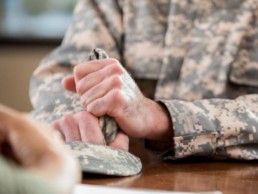4 Ways Veterans Can Take Control Of Their Finances
Taking control of your finances can be trying for anyone, but for struggling veterans, this issue may feel impossible to tackle. Luckily, there are lots of resources available, and the Purple Heart Foundation prides itself on helping military veterans and recognizing the sacrifices they’ve made. We would like to extend some information on how veterans can take control of their own finances on an individual basis.
1. Check Your Credit Score
Credit scores may not be the first thing on your mind when checking your bank accounts, but they are an extremely important tool that is needed when making big-ticket purchases. For example, buying a home will require a credit score check before you are able to take out a loan. Although VA loans offer flexibility to veterans, it’s still a great idea to first understand what credit score is needed to buy a home. Checking your credit score is free and won’t impact your credit. Plus, just this small step will allow you to gain a clearer picture of your financial situation.
2. Have a Plan to Pay Off Your Debts
Anyone struggling with debt understands the burden it can have. However, it’s crucial that big and small debts alike come with a plan for paying them off. Some of the more important factors to consider when creating a debt payoff plan that financial experts recommend is to include what your baseline budget will be and how much you’re going to allocate each month toward your debt payoff. Having an idea of how you’re going to pay your debts on time and eventually living debt free will be a huge weight off your shoulders and allow you more flexibility in your finances.
3. Cancel Unnecessary Subscriptions and Limit Overspending
Overspending is a common problem for many. There’s a reason such a thing as “retail therapy” exists! But that joy from buying a fancy back scratcher will quickly fade once you do the math on how much these unnecessary wants are costing you. Ways to combat emotional spending may include window shopping instead of buying so you can learn to understand what triggers your desire to overspend. Even taking a look at your monthly subscriptions, such as streaming services, and cutting back on those can help you increase your budget and improve your ability to meet long-term financial goals.
4. Save Up Toward Retirement
Lastly, retirement should be a huge consideration and part of your overall financial plan. Whether it’s through a 401(k) plan or savings account, having money set aside specifically for your retirement is a great way to start. Consider also speaking with a financial advisor to see exactly how much you and your family should save up to retire, and what your individual options are.
Taking control of your finances is no small task, and with the COVID-19 pandemic, this task may become that much more difficult. The Purple Heart Foundation is committed to helping veterans in whatever way possible, so we hope these steps will help you take control of your finances. If you would like to help veterans who are struggling financially, please be sure to check out our Veterans Critical Assistance Grant and make a donation today. Together, we can make a difference in the lives of our nation’s veterans.
Raising Awareness About Post Traumatic Stress
In WWI it was called Shell Shock; in WWII, Battle Fatigue. Korean War veterans were diagnosed with War Neurosis, and Vietnam vets with Post-Vietnam Syndrome. Whatever you call it, Post Traumatic Stress (PTS), as it’s now known, continues to affect hundreds of thousands of veterans.
Today is PTSD Awareness Day, a day to speak up about post-traumatic stress, a condition that’s underreported, misdiagnosed, and, so often, misunderstood.
PTS BY THE NUMBERS:
- 10-13% of combat veterans experience post-traumatic stress in their lifetimes.
- Studies estimate that 1 in 5 military personnel returning from Iraq and Afghanistan has PTS.
- PTS affects to 20% of Operation Enduring Freedom and Operation Iraqi Freedom veterans; 10% of Gulf War veterans, and 30% of Vietnam War veterans.
- 17% of combat troops are women; 71% of female military personnel develop PTS due to sexual assault within the ranks.
- The number of diagnosed cases of PTS in the military jumped 50% in the past year.
SEPARATING MYTH FROM FACT
The psychological scars of post-traumatic stress may be invisible, but its manifestations are not. Left untreated, it can lead to depression, drug and alcohol abuse, or suicide. Despite its prevalence, post-traumatic stress is often ignored, misinterpreted, and sensationalized by the media.
Listening to the stories of veteran experiencing post-traumatic stress can help us separate myth from fact.
MYTH: People begin experiencing PTS immediately after a traumatic event.
FACT: Sometimes symptoms surface months or years after a traumatic event or returning from deployment.
“ I was sober and clean almost 11 years, and I just couldn’t handle it no more, you know, my life. I couldn’t hold a job. I always had problems sleeping…very irritable, the whole bit. Plus, my family was always telling me I should go get some help.”
US Navy ((1971 – 1972))
SN, Ammunition Transporter
Vietnam
MYTH: Service members can never fully recover from PTS.
FACT: When people seek help and maintain a treatment program, post-traumatic stress symptoms can be managed or overcome entirely.
“My ability to overcome the situations that cause me to act negatively and not beneficial to me, are up to me, and I continue to seek treatment. I want to make a choice, not have my depression make the choice.”
Servicemen and Service Dogs: A Life Saving Connection
Our servicemen and women have to restart their lives upon returning home from battle. These new challenges can present circumstances far different from those of war. Facing these challenges head on can be daunting for many. Easing back into society can tough, especially for those who suffer from Post-Traumatic Stress (PTS) and Traumatic Brain Injury (TBI). According to the Veterans Administration (VA), between 11-20% of veterans during Operations Iraqi Freedom (OIF) and Enduring Freedom (OEF) have been diagnosed with PTS in a given year.
There are a variety of ways to ensure that transition is as smooth as possible. One of those methods is pairing a Veteran with a service dog. Suffering from PTS can leave an individual feeling isolated from family and friends. Depression and other emotional disorders can surface as well. The method of service dogs is to provide the veteran with a companion trained to help them with basic needs. However, the animal is indirectly re-teaching the veteran how to care for someone, using emotions as communication, and even how to love.
“We think pet dogs, therapy animals and service animals all have a role to play in peoples’ health and veterans’ health. This is all good news. A cold nose is a powerful motivation to get up in the morning,” said Stave Feldman, executive director of the Human Animal Bond Research Institute Foundation. Mr. Feldman discussed studies between the animals and veterans to The Military Times in a recent article.
“He brought me back from the brink,” said Veteran Colonel Roger Lintz, (US Army – Retired) of his Service Dog – Niles. Living with PTS does take time to accept that life may not be the same. This veteran, who honorably served his country, was able to find true companionship with his new four legged friend. Niles was able to help him with remedial tasks around the house and would wake him from nightmares. These nightmares and other issues with PTS nearly became too much to handle. Col. Lintz believes that his companion saved his life when suicidal thoughts started to cloud his mind. Watch the full interview:
The American Psychology Association and The Society Military Psychology have found that this alternative method could help nearly 40% of veterans. Especially those who do not show signs of improvement after participating in treatments such as prolonged exposure (PE) and cognitive processing therapy (CPT), which are considered the “gold standard” for treating PTS.
Maj. Todd Olsen had participated in multiple tours of duty since enlisting in the Army in 1989. However, coming back after his last mission sent his life into a tailspin. He was suffering from multiple symptoms of PTS, rebuilding a relationship with his two boys, and filing for divorce from his wife.
Some servicemen and women will attend the actual trainings with their service dog. They get to watch them go through obstacle courses, learn commands, and how to save lives. This, in a way, gives the veteran a sense of purpose again. Their life and bond matter as much to the service dog as the service dog means to them.
Maj. Todd Olsen of Pennsylvania told The Daily Progress that, “It’s not so much training the dog, it’s training the veteran and then pairing them up together. So we weren’t teaching them basic obedience, we were learning the commands and the dogs were learning how we give the commands.”
There have been few in-depth studies about the dynamic between a service dog and PTS. However, The Veterans Administration believes that veterans can experience some needed benefits by owning an animal or being paired with a service dog. The VA also counsels that veterans should speak with their doctor and family before applying for a service dog.
What are the emotional benefits of having a dog?
Dogs can make great pets. Having a dog as a pet can benefit anyone who likes dogs, including people with PTS. For example, dogs:
-
Help bring out feelings of love
-
Do things that are different from natural dog behavior
-
Do things that the handler (dog owner) cannot do because of a disability
-
Learn to work with the new handler in ways that help manage the owner’s disability
-
Are good companions
-
Take orders well when trained. This can be very comfortable for a Servicemember or Veteran who was used to giving orders in the military
-
Are fun and can help reduce stress
-
Are a good reason to get out of the house, spend time outdoors, and meet new people
(Source: The Veterans Administration)
Maj. Todd Olsen continues his transition into “civilian life” by working with his service dog and attending yoga classes. He says, “With the yoga for veterans and the dog, and continuing treatment at the VA, it’s putting me back together.”
The Purple Heart Foundation has provided funds to service dog programs totaling $75,000 over the years. The Purple Heart Foundation remains committed to assisting veterans in all aspects of their lives, including service dog programs, other rehabilitative programs, and disability benefits. You can show your support for these brave men and women who have sacrificed so much for our country by making a one-time or monthly pledge to ensure veterans continue to get the support and benefits they deserve by clicking here.
From Deployment to Employment: How to Adjust to a Civilian Work Environment
Transitioning from military service to a rewarding career can feel like a daunting undertaking. The work environment and requirements are usually pretty different. What made you successful in the military may not work as well or could even be counterproductive in civilian life.
Many veterans have trouble coping with this adjustment for several reasons:
- The lower stakes lead to boredom.
- The lack of straightforward rules and missions can cause confusion and anxiety.
- Survival behaviors learned during combat, like a flight or fight response, are counter-productive in a work environment.
- Stress and painful memories from deployment can make it difficult to concentrate and remember important information.
- Military skills don’t always translate to a new work environment.
But the structure and discipline you mastered during your military service can also help you succeed in a civilian work environment. Here are a few things to remember:
Focus on your health.
- See a doctor when necessary and only take medications as prescribed.
- Stay away from unhealthy foods (high fat, high sugar).
- Don’t use non-prescribed drugs or drink alcohol excessively.
- Keep a routine—get enough sleep, exercise regularly, eat at the same time each day.
Learn and practice communication skills.
- Maintain polite and friendly communication with co-workers
- Ask for help about talking about deployment with colleagues
- Learn the appropriate ways to handle conflict and criticism, taking into account the culture of your workplace.
Practice organization
- Keep you workspace neat
- Make task lists
- If you have trouble staying focused, write your thoughts in a journal or notebook.
Create your own structure
- Assess your values and make a list.
- Determine the ways your job fits with your values.
- To identify your values, ask yourself questions like:
- What kind of an employee do I want to be? Hard-working? Dependable? A trustworthy officer?
- What parts of work are important to me? Using and building my skills? Fixing problems? Leading a team of people?
- What do I like about my current job? The way people treat each other? The feeling of accomplishment? Good benefits?
- How does this job fit with serving my country?
- Set long-term goals, like an ideal future position or promotion, and then set short-term goals that will help you achieve them.
- Stay current on training and the technology used in your field.
If you are looking for some training, check out Purple Heart’s Veterans Vocational Technical Institute.
If you want to go back to school and complete an undergraduate degree, learn about Purple Heart scholarships.
For career counseling or other services, find a National Service Officer near you.
Resources:
TurboTAP (Transition Assistance Program)
Veterans’ Employment and Training Services
Military.com Veteran Employment Center
Giving Thanks for Freedom this Thanksgiving
Thanksgiving is a time to look back on the year gone by and reflect what you are thankful for. Thankfulness can come in many forms–having a new job, being able to provide for your family, or keeping friendships alive. For Americans, we have an extra reason to be thankful. Men and women in uniform working overseas and domestically make it possible for us to live in a free country.
For those who are overseas during the Thanksgiving holiday, the feeling can be bittersweet. Some are in war-torn areas fighting the enemy and most are away from the comforts of home and their families. There have been 152 recognized Thanksgiving holidays since its inception and despite being in unfamiliar territory, the armed forces have tried to make Thanksgiving as normal as possible for those deployed.
Even though the first nationally recognized Thanksgiving was not observed by the military because of a shortage of resources, over the years, there has been a push to have a Thanksgiving meal, regardless of where a service member is stationed. This food is usually gathered starting in May and sent out with the temperature-controlled food taking up to three months to reach its destination.
According to the Department of Defense, this is how much food was shipped out to various military bases across the world to prepare for a Thanksgiving feast last year:
-
51,699 pounds of turkey
-
25,970 pounds of beef
-
17,130 pounds of ham
-
706 gallons of eggnog
-
3,360 pounds of marshmallows
That is the equivalent to:
-
17 adult female hippos
-
14 1/2 Smart cars
-
24 male zebras
-
45 1/2 full kegs of beer
-
122 gold bars
The gathering of food doesn’t just stop at traditional holiday fare either. The Oak Lawn Park district in Illinois held its 6th annual Treats for Troops drive to send leftover and extra Halloween candy to those serving overseas.
While having a hot dinner can help stave off the feeling of homesickness during the holiday season, physically being with family and friends can make the holidays that much better. Spencer Girard, a seaman stationed in Norfolk, VA won a “Happy ThanksGathering” lottery to be the only person out of all the sailors and Marines stationed to be reunited with his family for the holiday. Katherine Girard said she hadn’t seen her son in a year and a half and being with him for the holidays last November was extra special, “The way they did it was just … oh my goodness. I didn’t know Norfolk was the world’s largest naval station, but you see when you get there. They spent a huge amount of money to treat everyone to a great Thanksgiving.”
On November 5, 2016, in the Albuquerque Convention Center while being welcomed back with the 126th Military Police Company from the Middle East, Specialist Rene Lopez held her daughter Amaya as her husband Specialist Jassen Lopez looked on. The couple were deployed to Kuwait together and left their four children, ages 3 to 8, in the care of family.
“Thanksgiving has come early to the people of the state of New Mexico,” Brigadier General Andy Salas, the state Guard’s adjutant general, told the crowd. The 120 soldiers who performed custom inspections-type work in maritime ports and airports across different parts of the Middle East wasn’t due back to the United States until January.
Kristen Smith, an Army wife, understands the changing nature of spending the holidays with someone in the military. Last year, she recalled how different the past 11 Thanksgivings have been with, and without, her husband. Thanksgiving celebrations varied greatly from sitting on the couch with her son watching movies to finally having her husband home last year for a “shockingly normal holiday.” For Smith, having such different variations of celebrating the Thanksgiving holiday has helped her be grateful in a way that she “could never have understood 12 years ago.”
During this holiday season, and every season, we are thankful for the work our troops do overseas so we can enjoy the freedom we have today. The Purple Heart Foundation is committed to assisting veterans in all aspects of their lives, including helping those who are in need of assistance while transitioning home from the battlefield. You can show your support for these brave men and women who have sacrificed so much for our country by making a one-time or monthly pledge to ensure veterans continue to get the support and benefits they deserve by clicking here.
“A Date Which Will Live In Infamy”: Remembering Pearl Harbor
December 7th marks the 75th anniversary of the attacks on Pearl Harbor. The two hour sneak attack by the Japanese left nearly 20 American naval vessels and more than 300 airplanes destroyed. Over 2,000 lives were lost and another 1,000 American soldiers and sailors were left injured. Three days later, after Congress approved President Franklin D. Roosevelt’s request to wage war on Japan, the United States joined other nations in World War II.
Much has changed for America since that day, but the feelings that survivors have about that day have not changed. Earl Brandes, Ed Guthrie, and Lawrence Osterbuhr were stationed in Honolulu the day Pearl Harbor was attacked. Now, 75 years later, all three men are back in their home state of Nebraska–Brandes is 95, Guthrie is 97, and Osterbuhr is 96.
“We’re really comrades,” Brandes said. “There’s not too many people left our age.” The three men used to be part of the Pearl Harbor Survivors Association, Nebraska chapter, but the group disbanded after December 2011 after the national organization decided there were too few members around to warrant a group. Since the group’s disbandment, the Sons and Daughters of Pearl Harbor Survivors, a group started in 1958, has helped to preserve the memory of those who served during the attack. “The Sons & Daughters wanted to make sure nobody forgot about Pearl Harbor,” Peg Murphy, Ed Guthrie’s daughter and the leader of the Nebraska chapter of the Sons & Daughters said.
Donald Stratton, another Pearl Harbor survivor from Red Cloud, Nebraska remembered the attack when he was a Seaman 1st Class aboard the USS Arizona. He and 1,177 shipmates managed to escape the Arizona for a neighboring ship and were spared during the attack. Stratton is now 94 years old, residing in Colorado Springs.
“The morning of Dec. 7, 1941, seemed like any other. We worked out a little bit and ate chow. I grabbed a few oranges to bring to a buddy of mine who was in the sick bay. Then I walked out onto the deck and saw some sailors congregating on the ship’s starboard side. They were looking across the water at Ford Island, an islet in the center of Pearl Harbor, and they were hollering — planes with the Japanese Zero insignia were banking through the sky.‘Oh, hell, it’s the Japanese!’ somebody shouted. ‘They’re bombing the water tower on Ford Island.’ We watched the tower fall and planes on the runway over there burst into flames,” Stratton said.
Across the nation, December 7th is a national day of remembrance. In El Paso, Colorado, Jim Downing was made a member of the El Paso County Commissioners just as a commemoration announcement for Pearl Harbor Day was announced. “My message to this generation: You are the leaders, you are the taxpayers, you are the voters, you are the legislators. Weakness invites aggression; keep America strong,” Downing said. “I want to keep America so strong that no adversary will ever think of attacking us.” Downing is one of the oldest living survivors at 103 years old.
In Hawaii, the war memorials for the attack are alive and thriving. This December 7th, people from all backgrounds will stand on Kilo Pier with the USS Arizona Memorial behind them to remember what happened. At the memorial, visitors can see pieces of metal from the downed ship in the water. The metal is still wet with oil that continuously leaks from the ship 75 years later. In addition, Hangar 79 at the Pacific Aviation Museum holds artifacts recovered from the site.
December 7, 1941 was a day of great loss for our country. It entered us into a war and the pain of the attack is still felt by survivors today. Now, we remember those who lost their lives in service to our country and try to keep their memory alive.
On December 7th, and every day, we remember the great sacrifice our soldiers and sailors made. The Purple Heart Foundation is committed to assisting veterans in all aspects of their lives, including helping those who are in need of assistance while transitioning home from the battlefield. You can show your support for these brave men and women who have sacrificed so much for our country by making a one-time or monthly pledge to ensure veterans continue to get the support and benefits they deserve by clicking here.
Whiskey With A Cause: The Glenlivet 14 Year Old
The Purple Heart Foundation is solely dedicated to serving our nation’s heroes and The Glenlivet has joined our cause!
The Glenlivet is commemorating Purple Heart Month by partnering with the Purple Heart Foundation to introduce the brand new 14-Year-Old single malt scotch whiskey, in honor of our heroes. You still have time to buy a bottle of this newly crafted sing malt scotch whisky. Every purchase benefits the Purple Heart Foundation! For every bottle of The Glenlivet 14-Year-Old sold at participating retailers from July 1 to December 31, 2019, The Glenlivet will donate $1 to the Purple Heart Foundation, with a minimum guaranteed donation of $50,000, up to $100,000! The Glenlivet’s generosity will help the Purple Heart Foundation enhance the quality of life for thousands of veterans and their families across the country.
We invite you to buy a bottle of The Glenlivet 14-Year-Old and raise your glass in honor of all our heroes. Your purchase or donation will make a difference, and it will help us fund resources and programs that are so desperately needed by our veterans today. Anyone (over 21) can still honor a Purple Heart recipient this Purple Heart Month by purchasing a bottle of The Glenlivet 14-Year-Old from your local participating retailer this August!
To read more about The Glenlivet in the official press release, please click HERE.
To buy a bottle of The Glenlivet 14 Year Old, please click HERE.
To DONATE to the Purple Heart Foundation, please click HERE.








